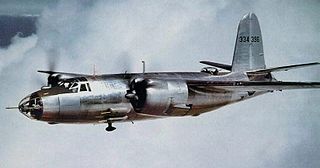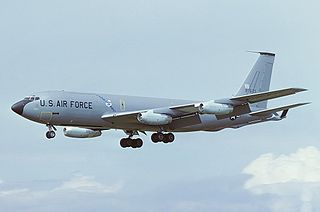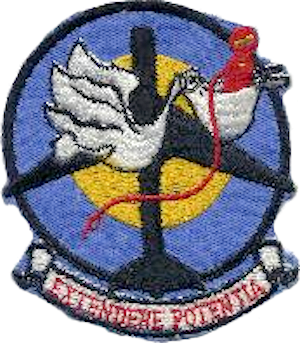
The 393d Bombardment Group is a disbanded United States Air Force unit. It was part of Second Air Force, and last stationed at Sioux City Army Air Base, Iowa, where it was inactivated on 1 April 1944. During World War II the group was a Boeing B-17 Flying Fortress Operational Training Unit, and later a Replacement Training Unit. It was inactivated in April 1944 in a general reorganization of Army Air Forces training units.

The 396th Bombardment Group is a former United States Army Air Forces unit. It was active during World War II as a Boeing B-17 Flying Fortress Operational Training Unit, training newly organized units, then as a Replacement Training Unit for aircrews. It was inactivated in 1944 in a general reorganization of Army Air Forces training units..

The 470th Electronic Warfare Group is an inactive United States Air Force unit. It was last active as a crew training unit during World War II as the 470th Bombardment Group at Tonopah Army Air Field, Nevada, where it was disbanded on 31 March 1944. In 1985, the group was redesignated as an electronic warfare unit, but has not been active since then.

The 400th Tactical Missile Wing is an inactive United States Air Force unit. It was last active as the 400th Bombardment Group, a World War II Consolidated B-24 Liberator Replacement Training Unit. The unit was disbanded in 1944 in a general reorganization of Army Air Forces training units. It was reconstituted as a missile wing in 1985, but has not been active since then.

The 338th Bombardment Group is a disbanded United States Air Force unit. It was last active with Continental Air Command at O'Hare International Airport, Illinois on 27 June 1949. It was first activated during World War II as the 338th Fighter Group and served primarily as a training unit until it was disbanded in 1944. The group was reconstituted in the reserves in 1947, but was inactivated when military spending was reduced in 1949.
The Los Angeles Fighter Wing was a unit of the United States Army Air Forces. The wing provided air defense of southern California and trained fighter units and pilots. It was stationed at Los Angeles, California, where it was disbanded on 7 June 1944.

The San Francisco Fighter Wing is a disbanded United States Air Force unit. The wing provided air defense of the central Pacific coast and trained fighter units and pilots. It was stationed at San Francisco, California, where it was disbanded on 7 June 1944.

The 546th Fighter Squadron is a disbanded United States Air Force unit. Its last assignment was to the 478th Fighter Group at Portland Army Air Base, Oregon, where it was disbanded on 31 March 1944. During World War II the squadron served as a Bell P-39 Airacobra replacement training unit.

The 469th Bombardment Group is a former United States Army Air Forces (AAF) unit. It was activated in May 1943 and served as a Replacement Training Unit until it was disbanded in April 1944 when the AAF reorganized its training and support units in the United States.

The 395th Bombardment Group is an inactive United States Air Force unit. It was part of Second Air Force, serving as a heavy bomber training unit from February 1943 until it was inactivated on 1 April 1944 in a reorganization of Army Air Forces training units..

The 88th Bombardment Group is an inactive United States Air Force unit. During World War II, the group served as a training unit for Boeing B-17 Flying Fortress units and aircrews. It was inactivated in May 1944, when the Army Air Forces reorganized its training units, replacing units like the 88th that were organized under rigid tables of organization.

The 411th Bombardment Group is an inactive United States Army Air Forces unit. Its last assignment was with III Bomber Command at Florence Army Air Field, South Carolina, where it served as a Replacement Training Unit until it was disbanded on 1 May 1944. In July 1985, the group was reconstituted as the 411th Tactical Missile Wing, but has never been active under that name.

The 335th Air Refueling Wing is an inactive United States Air Force unit. The group was active at Barksdale Field, Louisiana from July 1942 as a training unit for medium bomber aircrews. It was disbanded in May 1944, when the Army Air Forces reorganized its training and support units in the United States. The group was reconstituted in 1985 as the 335th Air Refueling Wing, but has not been active since then.

The 467th Bombardment Squadron is an inactive United States Air Force unit. It served during World War II as an Operational Training Unit, and later as a Replacement Training Unit. It was inactivated at Dalhart Army Air Field, Texas in the spring of 1944 in a general reorganization of Army Air Forces support and training units in the United States.

The 380th Air Refueling Squadron is an inactive United States Air Force unit. It was last assigned to the 380th Bombardment Wing at Plattsburgh Air Force Base, New York where it was inactivated on 30 September 1995.

The 308th Air Refueling Squadron is an inactive United States Air Force unit. It was last assigned to the 2d Bombardment Wing at Hunter AFB, Georgia. It was inactivated on 1 March 1960.

The 450th Fighter Squadron was established during World War II as a Replacement Training Unit for Republic P-47 Thunderbolt pilots until it was disbanded in a major reorganization of the Army Air Forces in 1944 designed to streamline training organizations.

The 544th Fighter Squadron is a disbanded United States Air Force unit. Its last assignment was to the 478th Fighter Group at Paine Field, Washington, where it was disbanded on 31 March 1944. During World War II the squadron served as a Bell P-39 Airacobra replacement training unit.

The 545th Fighter Squadron is a disbanded United States Air Force unit. Its last assignment was to the 478th Fighter Group at Portland Army Air Base, Oregon, where it was disbanded on 31 March 1944. During World War II the squadron served as a Bell P-39 Airacobra replacement training unit.

The 31st Troop Carrier Squadron is a disbanded United States Air Force unit. It was established in January 1942 as the 31st Transport Squadron and served as a training unit for I Troop Carrier Command until disbanding in a general reorganization of Army Air Forces training units in 1944.















